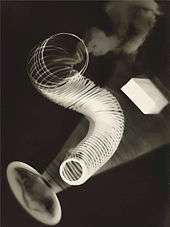Photogram

A photogram is a photographic image made without a camera by placing objects directly onto the surface of a light-sensitive material such as photographic paper and then exposing it to light. The usual result is a negative shadow image that shows variations in tone that depends upon the transparency of the objects used. Areas of the paper that have received no light appear white; those exposed through transparent or semi-transparent objects appear grey.[1]
The technique is sometimes called cameraless photography. It was used by Man Ray in his exploration of rayographs. Other artists who have experimented with the technique include László Moholy-Nagy, Christian Schad (who called them "Schadographs"), Imogen Cunningham and Pablo Picasso.[2] Variations of the technique have also been used for scientific purposes.
History


Some of the first photographic images made were photograms. William Henry Fox Talbot called these photogenic drawings, which he made by placing leaves and pieces of material onto sensitized paper, then left them outdoors on a sunny day to expose. This produced a dark background with a white silhouette of the object used.[3]
From 1843, Anna Atkins produced a book titled British Algae: Cyanotype Impressions in installments; it was the first book to be illustrated with photographs. The images were all photograms of botanical specimens, which she made using Sir John Herschel's cyanotype process, which yields blue images.[4] This very rare book can be seen in the National Media Museum in Bradford, England.
Man Ray's rayographs
Photograms were used in the 20th century by a number of photographers, particularly Man Ray, who called them "rayographs". His style capitalised on the stark and unexpected effects of negative imaging, unusual juxtapositions of identifiable objects (such as spoons and pearl necklaces), variations in the exposure time given to different objects within a single image, and moving objects as the sensitive materials were being exposed. Contemporary artists who are widely known for using photograms are Adam Fuss, Susan Derges and Christian Marclay.

Procedure
In a darkroom, or a darkened room, objects are arranged on top a piece of photographic material, usually photographic paper. When the operator is satisfied with the arrangement, the photographic material is exposed with light, usually by switching on an enlarger or other artificial light source. The material is then processed, washed and dried.[5]
List of notable photographers using photograms

- Markus Amm
- Anna Atkins
- Walead Beshty
- Christopher Bucklow
- Kate Cordsen
- Susan Derges
- Michael Flomen
- Adam Fuss
- Raoul Hausmann
- John Herschel
- Len Lye
- László Moholy-Nagy
- Pablo Picasso
- Man Ray
- Alexander Rodchenko
- Christian Schad
- Greg Stimac
- Kunié Sugiura
- Elsa Thiemann
- Kurt Wendlandt
- Nancy Wilson-Pajic
- Willie Ann Wright
- Keith Carter
See also
| Wikimedia Commons has media related to Photogram. |
- Drawn-on-film animation, another form of cameraless image making
- Neues Sehen, László Moholy-Nagy's 'New Vision' photography movement
References
- ↑ Langford, Michael (1999). Basic Photography (7th ed.). Oxford: Focal Press. ISBN 0-240-51592-7.
- ↑ According to Alexandra Matzner in Christian Schad 1895-1982 Retrospectief issued by the Gemeentemuseum Den Haag (2009), ISBN 978-3-87909-974-0, p. 216, Schad was the first artist to use the photogram technique, developed by William Henry Fox Talbot. The photogram was applied by Man Ray, Moholy-Nagy and Chargesheimer after its introduction by Christian Schad, according to the author. However, this is not substantiated through further reference by Matzner. The Dutch catalogue was also issued in German by the Leopold Museum in Vienna (2008).
- ↑ Talbot, William Henry Fox (1844). The Pencil of Nature. London: Special Collections Department, Library, University of Glasgow. Retrieved 21 November 2010.
- ↑ "Anna Atkins". vam.ac.uk. Retrieved 21 November 2010.
- ↑ Bargh, Peter. "Making a photogram - traditional darkroom ideas". ePhotozine.com. Magazine Publishing Ltd. Retrieved 2 January 2012.